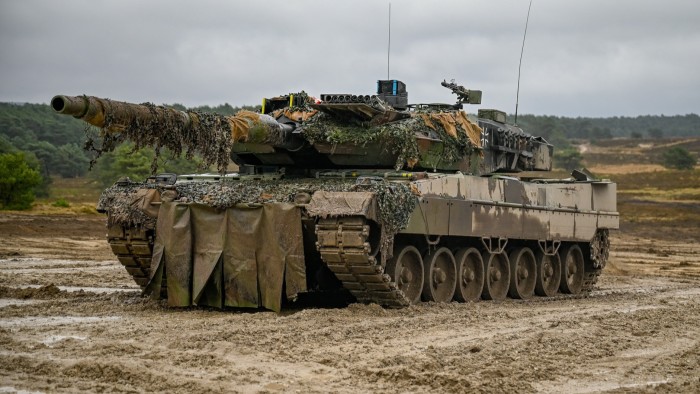Ukrainian troops to start training on Leopard 2 tanks next week

Simply sign up to the War in Ukraine myFT Digest -- delivered directly to your inbox.
Ukrainian soldiers will start training on Leopard 2 tanks next week as part of an EU-funded training mission, as Kyiv’s allies seek to deploy the newly pledged vehicles ahead of a feared Russian offensive this spring.
Two people familiar with the preparations said everything was ready to begin teaching the Ukrainian military to deploy the modern battle tanks after several European nations last week pledged to send them to Kyiv after months of deliberations and Ukrainian pressure.
Berlin’s decision to send the German-made Leopard 2s marked a watershed moment in western support for Ukraine by agreeing to supply large numbers of modern Nato-standard main battle tanks.
The decision has visibly angered Russia. Speaking in Volgograd on Thursday — renamed Stalingrad for a day to celebrate the 80th anniversary of the Soviet victory over Nazi Germany there — president Vladimir Putin warned the west of consequences for supporting Kyiv.
“We have been forced to resist the collective west’s aggression again and again,” Putin said. “It’s amazing, but true: we are being threatened by German tanks sporting crosses again,” he added.
In his latest thinly veiled threat about deploying nuclear weapons, Putin warned Germany and other European countries “that a modern war with Russia will be very different”. He added: “We are not sending our tanks to their borders, but we have ways of responding, and it won’t be limited to using armoured vehicles.”
Germany also agreed for other countries who operate the tank to send them to Ukraine. That can only happen after enough Ukrainian tank crews have been trained to use them.
The final details of the training plan were thrashed out at a US-led meeting of western defence officials in Germany on Wednesday. The training is expected to last about six weeks.
Josep Borrell, the EU’s defence and security chief, said ahead of meetings with Ukrainian defence officials in Kyiv on Thursday that “crews of the battle tanks” would be trained under the EU mission, describing the vehicles as “a strong reinforcement of the Ukrainian military capability”.
“Training will start from next week,” said one of the people, adding that hundreds of Ukrainian soldiers had already flown to locations across Germany and Poland. “It’s all going very quickly because the Ukrainians see the urgency.”
“Politically, it is cleared,” said a second official.
The news comes as the EU on Thursday announced plans to instruct 30,000 Ukrainian troops through its training mission, double the initial planned amount.
The EU will also increase the mission’s budget by €45mn, and raise its funding for weapons supplied to Ukraine by €500mn to €3.6bn.
The EU established the initiative in October, with an initial duration of two years. The unprecedented step was aimed at pooling member states’ capabilities to teach Ukrainians how to use western weapons being provided to Kyiv, and to provide “individual, collective and specialised training” to troops.
European defence officials have rushed to tackle a range of practical problems, including securing enough beds and kitchens to accommodate the Ukrainian soldiers and finding sufficient translators.
Officials are also grappling with challenges of how to transport the vehicles to the front lines. “If you want to bring them in time, before April, you can imagine how many trains, cars you need to get them there,” said one of the officials. “That’s only vehicles. [There are] also spare parts, ammunition — and time is limited.”
The successful campaign to give Ukraine tanks has emboldened some of Kyiv’s most ardent supporters in the EU to push for new supplies of advanced weapons such as fighter jets and long-range missiles.
Sergei Lavrov, Russia’s foreign minister, warned such a move risked prolonging the war. “Now we are striving to push away [Ukrainian] artillery to a distance that will not threaten our territory,” he said in an interview with state newswire Ria Novosti. “The longer the range of weapons supplied to the Kyiv regime by the West, the further away we need to move them from Russian borders,” he added.
Comments